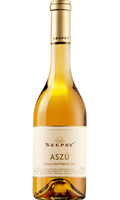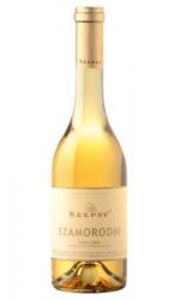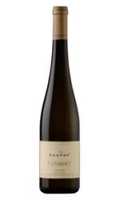-
Home
-
Contributors
-
International
-
Account
-
Information
More From Contributor
Colour: lively golden yellow Nose: elegant & expressive & its honey, pear & baked apple notes inviting you you taste it. Palate: creamy & refreshing with its beautiful ginger, pear & apple flavours. A very complex wine. Enjoy just by itself or with flavourful, spicy food. A brilliantly balanced wine, seamlessly combining enduring ripe yellow fruit perfumes & flavours with a delicate velvety texture & a delicious minerally crisp elegance. There are winemakers & there are alchemists; how else could you explain the pureness of Szepsy's wines, the elegance of his fruit & the harmony of structure? & yet, like most great wine-makers, his wines are not about what he does as much as what he does not do. There is no over-working the fruit at this estate, no unbalanced wines due to 'ambitious' winemaking. The philosophy is all about preserving the quality of the fruit & not about enhancement by artifice or sleight of h&. If Szepsy's fruit traces the purest possible line from the vineyard to the bottle, the man himself can boast a lineage that goes back close to the origins of Tokaji: He is the direct descendant of Szepsy Lacko Mate who, in 1631 was the first person to write down the Tokaji making process. Szepsy has around 50 hectares under vine in largely rocky, volcanic soil. Though traditional in his approach, he constantly searches for new refinements in his quest for perfection. Fermentation & maturation takes place in wood. His yields have been described by none other than Michel Bettane of the Revue du Vin de France as ridiculously low (we could add, off course that they are Mad!). The wines have an almost sacred reputation & justifiably so as this example will prove. ...
- the balance, intensity & complexity & sheer drinkability of this wine ...
Colour: clear, straw yellow colour. Nose: elegant with expressive spices, lime & apple notes. Palate: vibrant, long ...
Colour: clear, straw yellow colour. Nose: elegant with expressive spices, lime & apple notes. Palate: vibrant, ...
Colour: golden yellow. Nose: elegant, rich, notes of figs, pineapple, peaches & citrus fruit. Palate: this is the ...
- enjoyed as the aperitivo of the people. Championing the humble bergamot fruit, Italicus is produced at a family-owned distillery established in 1906 in Moncalieri, Torino. Bergamot from the UNESCO-protected area in the Calabrian region & cedro from Sicilia are infused in cold water to release their essential oils, in a time honoured process called Sfumatura, before being blended with Italian neutral grain spirit. A delicate combination of Roman chamomile from Lazio, lavender, gentian, yellow roses & melissa balm from Northern Italy are then macerated together for several days before being married with the bergamot & cedro essential oils to create the final liquid. Italicus founder Giuseppe Gallo comments, This is an incredible moment in my career & Im very pleased to share it with some of the best in the business, who Im proud to call my friends. The launch of Italicus marks the end of a life-long ambition to bring back the Rosolio category which was first born during the renaissance with Caterina de Medici in Firenze. Italicus is personal to me as Ive introduced elements of my own familys recipes that go back many generations. Over the past few years I have sourced some of the finest ingredients that my beloved Italy has to offer, including the unique taste of cedri from Sicilia & of course the wonderful bergamot from Calabria. It has been my childhood dream to create the quintessential expression of what makes Italy the most remarkable & unforgettable country in the world for so many people, bottling the essence of La Bella Italia Rosolio means the dew of the sun & Italicus is truly a sip of Italy, bringing a forgotten category back to the cocktail industry at long last. ...
Istvan Szepsy - Tokaji Aszu, 6 Puttonyos 2007 50cl Bottle
boast a lineage that goes back close to the origins of Tokaji: He is the direct descendant of Szepsy Lacko Mate who, in 1631 was the first person to write down the Tokaji making process. Tokaj wine region is a historical wine region located in northeastern Hungary. It is also one of the seven larger wine regions of Hungary. The region consists of 28 named villages and 11, 149 hectares of classified vineyards, of which an estimated 5, 500 are currently planted. Tokaj has been declared a World Heritage Site in 2002 under the name Tokaj Wine Region Historic Cultural Landscape. The term Aszu refers to the shrivelled grape berries that are created by way of overripe grapes and noble-rot (botrytisation) occurring upon the vines. The Aszu wine is made of grape berries that have shrivelled and
stewed as a result of noble rot, under attack by the botrytis cinerea fungus. If after a warm summer the cool, foggy dawns are followed by sunshine, due to the beneficial effect of the fungus the process of botrytisation commences. The process of making of Tokaji Aszu is extremely labour intensive. The Aszu berries are selected from the vines by hand after which they are collected in wooden vessels puttonyos each of which is capable of storing 20-25kg of Aszu berries. The puttony number between 3-6 designates how many Aszu berries were used to make one barrel (136 l) of wine. After the must is perfected, small cloth containers are filled with the sweet pulp and juice of Aszu grapes and added to the wine. Furmint is the dominant grape in Tokaji and Aszu in the name simply to the dried,
nobly-rotted grapes, which are hand-picked from vines. The number of puttonys is an indication of sweetness, with two the driest and six the sweetest. That is the reason why it is important not to mix up the Hungarian Tokaji Aszu with the Slovenian variety, called Tokajsky wine as the difference is more significant as you would expect from the names. Szepsy has around 50 hectares under vine in largely rocky, volcanic soil. Though traditional in his approach, he constantly searches for new refinements in his quest for perfection. Fermentation and maturation takes place in wood. His yields have been described by none other than Michel Bettane of the Revue du Vin de France as ridiculously low (we could add, off course that they are Mad!). The wines have an almost sacred reputation and
justifiably so as this example will prove.
- Availability: In Stock
- Supplier: TheDrinkShop
- SKU: 11174-33884
Product Description
Undeniably one of the world's great classic sweet wines
- the balance, intensity & complexity & sheer drinkability of this wine show the tiny Szepsy winery to be one of the best on the planet! There are winemakers & there are alchemists; how else could you explain the pureness of Szepsy's wines, the elegance of his fruit & the harmony of structure? & yet, like most great wine-makers, his wines are not about what he does as much as what he does not do. There is no over-working the fruit at this estate, no unbalanced wines due to 'ambitious' winemaking. The philosophy is all about preserving the quality of the fruit & not about enhancement by artifice or sleight of h&. If Szepsy's fruit traces the purest possible line from the vineyard to the bottle, the man himself can boast a lineage that goes back close to the origins of Tokaji: He is the direct descendant of Szepsy Lacko Mate who, in 1631 was the first person to write down the Tokaji making process. Tokaj wine region is a historical wine region located in northeastern Hungary. It is also one of the seven larger wine regions of Hungary. The region consists of 28 named villages & 11, 149 hectares of classified vineyards, of which an estimated 5, 500 are currently planted. Tokaj has been declared a World Heritage Site in 2002 under the name Tokaj Wine Region Historic Cultural Landscape. The term Aszu refers to the shrivelled grape berries that are created by way of overripe grapes & noble-rot (botrytisation) occurring upon the vines. The Aszu wine is made from grape berries that have shrivelled & stewed as a result of noble rot, under attack by the botrytis cinerea fungus. If after a warm summer the cool, foggy dawns are followed by sunshine, due to the beneficial effect of the fungus the process of botrytisation commences. The process of making of Tokaji Aszu is extremely labour intensive. The Aszu berries are selected from the vines by hand after which they are collected in wooden vessels puttonyos each of which is capable of storing 20-25kg of Aszu berries. The puttony number between 3-6 designates how many Aszu berries were used to make one barrel (136 l) of wine. After the must is perfected, small cloth containers are filled with the sweet pulp & juice of Aszu grapes & added to the wine. Furmint is the dominant grape in Tokaji & Aszu in the name simply to the dried, nobly-rotted grapes, which are h&-picked from vines. The number of puttonys is an indication of sweetness, with two the driest & six the sweetest. That is the reason why it is important not to mix up the Hungarian Tokaji Aszu with the Slovenian variety, called Tokajsky wine as the difference is more significant as you would expect from the names. Szepsy has around 50 hectares under vine in largely rocky, volcanic soil. Though traditional in his approach, he constantly searches for new refinements in his quest for perfection. Fermentation & maturation takes place in wood. His yields have been described by none other than Michel Bettane of the Revue du Vin de France as ridiculously low (we could add, off course that they are Mad!). The wines have an almost sacred reputation & justifiably so as this example will prove.
Reviews/Comments
Add New
Intelligent Comparison
Price History
Vouchers
Do you know a voucher code for this product or supplier? Add it to Insights for others to use.


 United Kingdom
United Kingdom
 France
France
 Germany
Germany
 Netherlands
Netherlands
 Sweden
Sweden
 USA
USA
 Italy
Italy
 Spain
Spain














 Denmark
Denmark